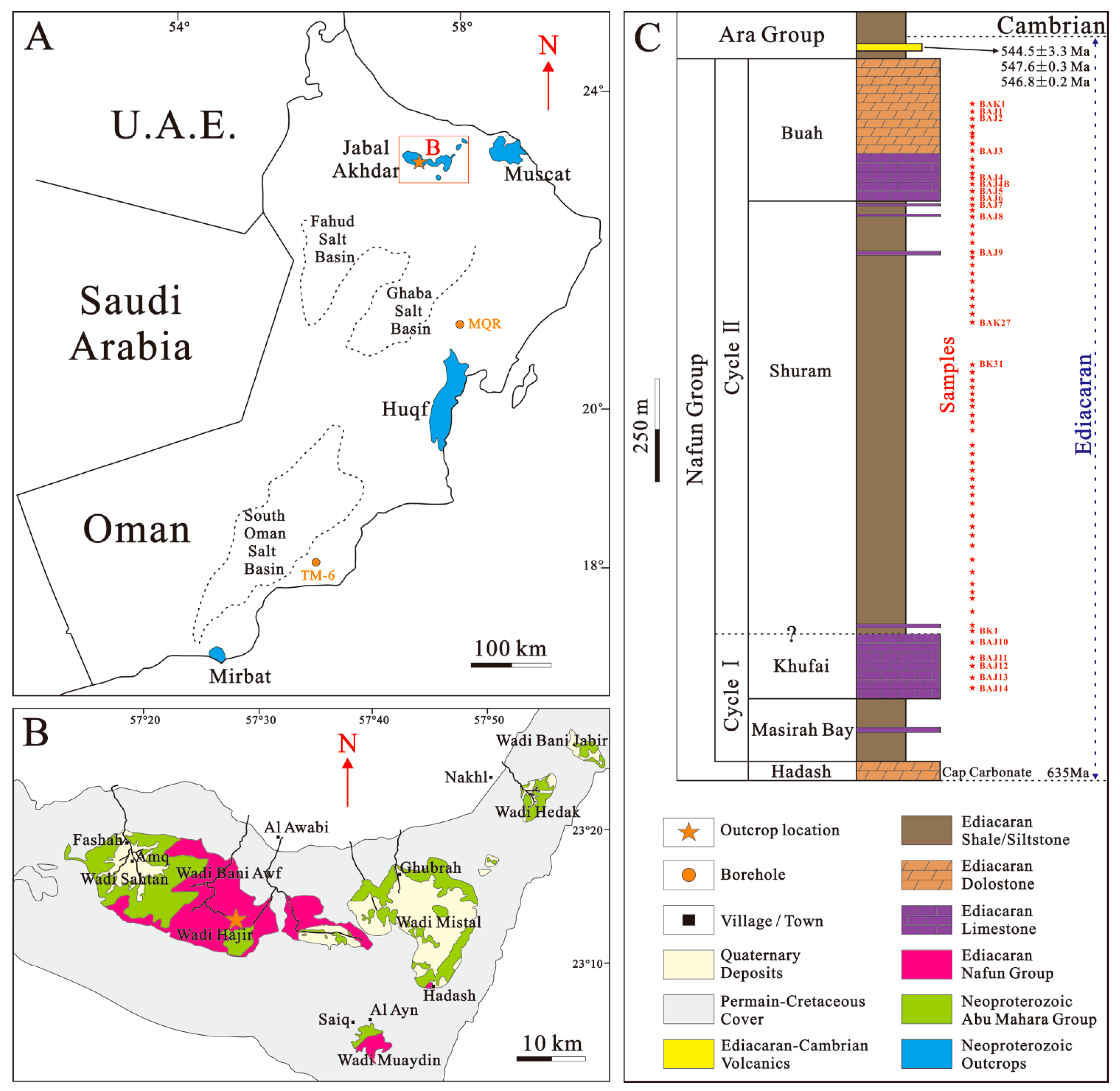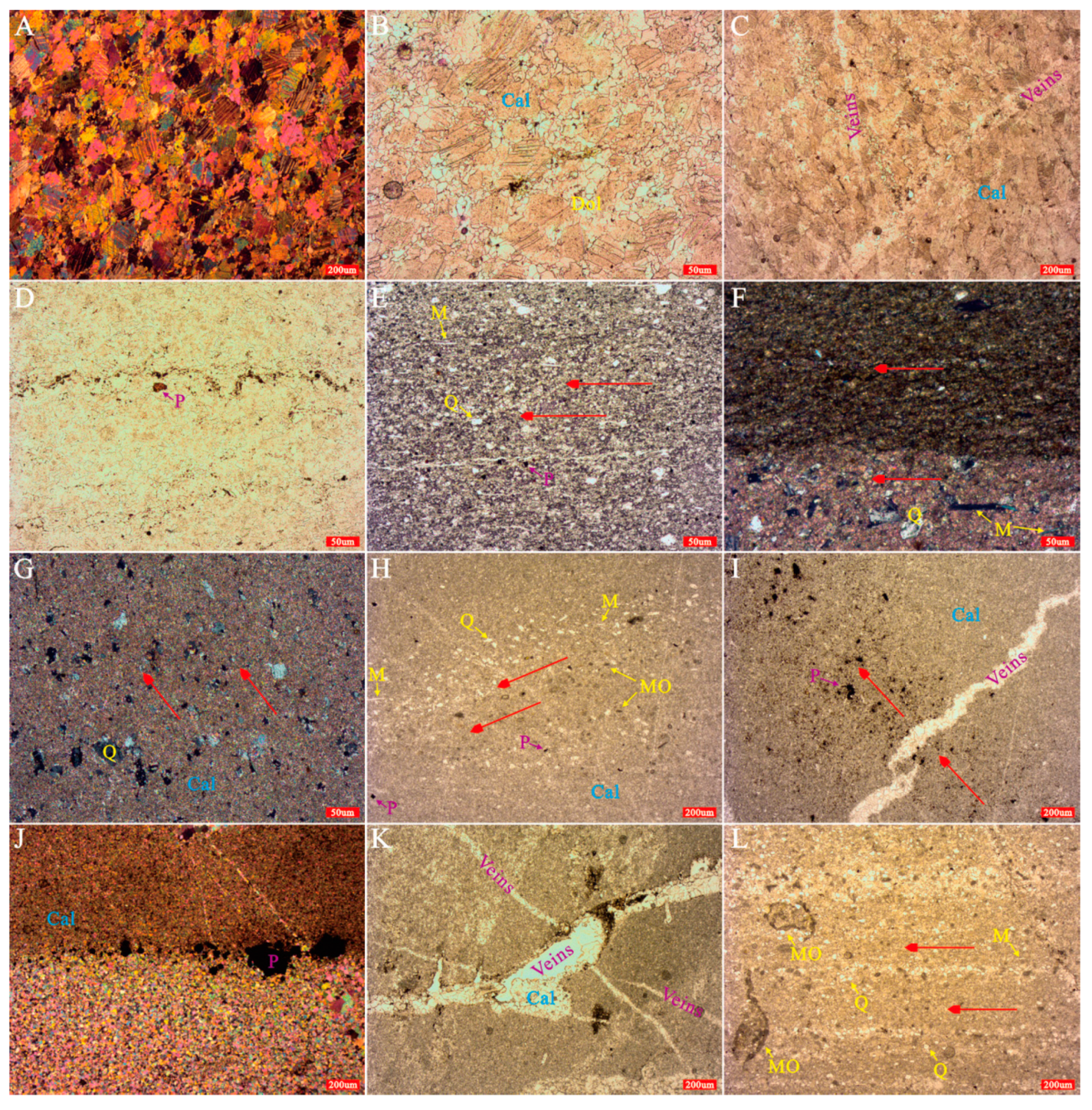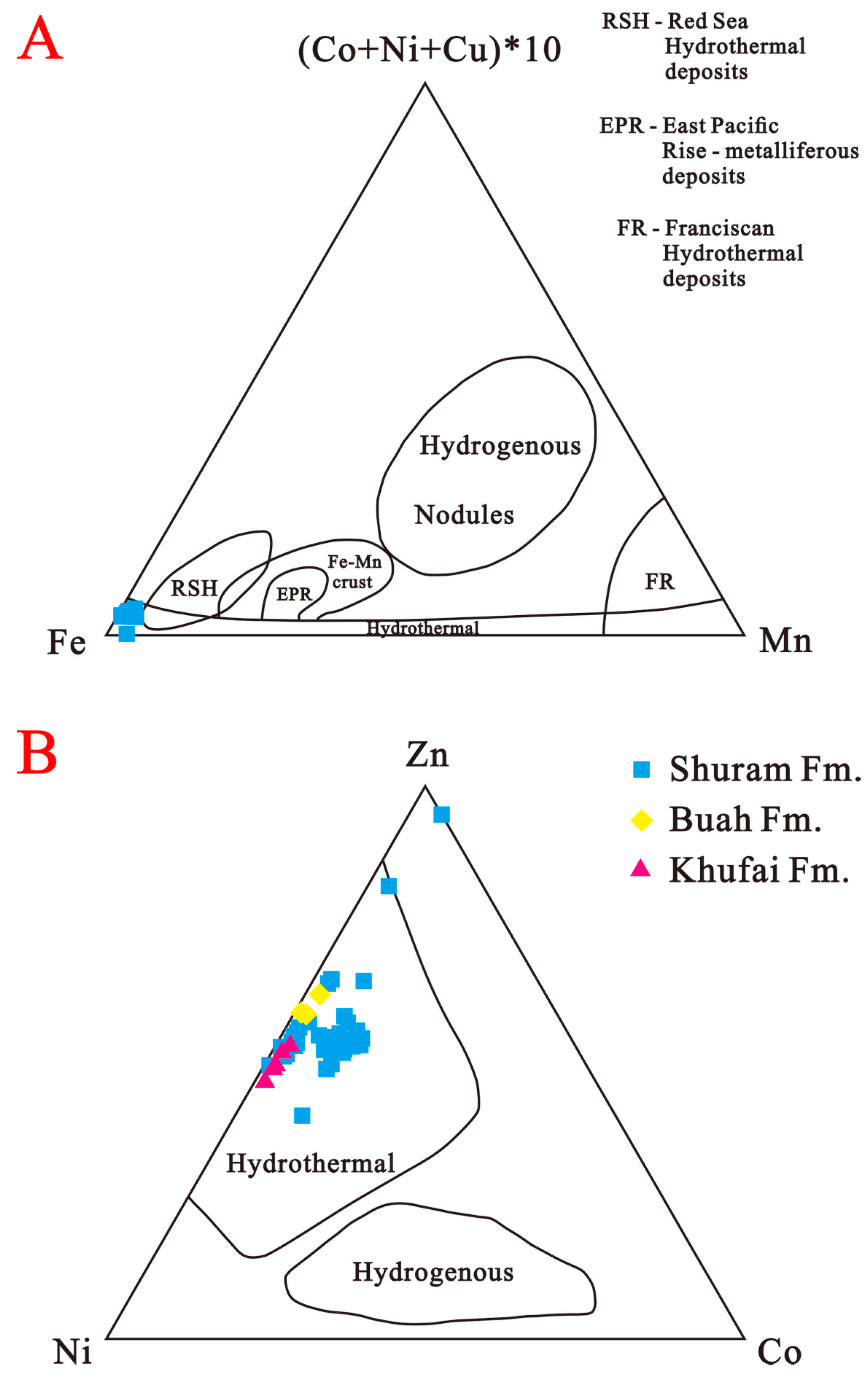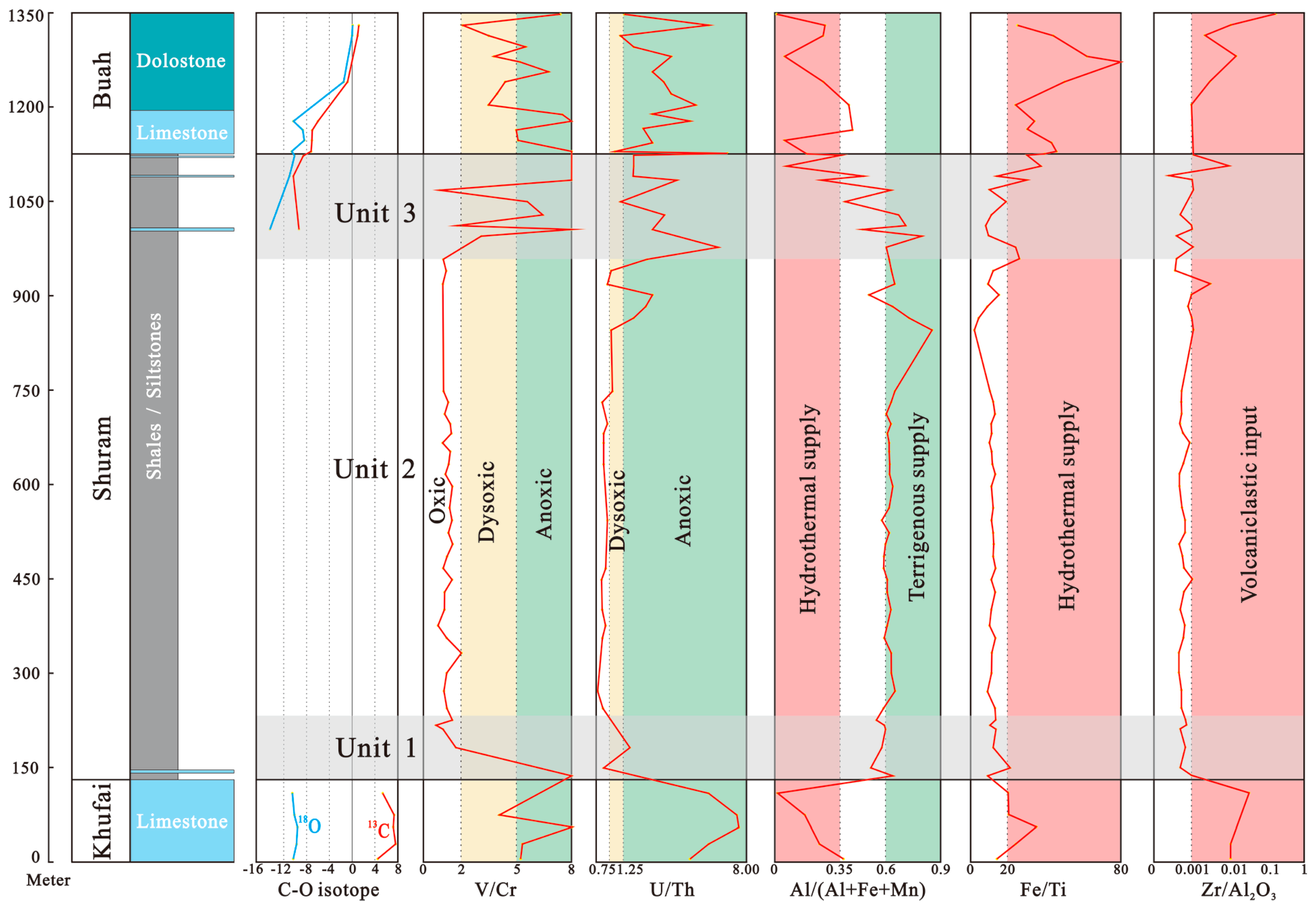Neoproterozoic Nafun Group Sediments from Oman Affected by an Active Continental Margin
Abstract
:1. Introduction
2. Geological Setting
3. Materials and Methods
3.1. Materials
3.2. Analytical Methods
4. Results
4.1. Petrography
4.1.1. Khufai Formation
4.1.2. Shuram Formation
4.1.3. Buah Formation
4.2. Major and Trace Elements
4.3. Carbon and Oxygen Isotopes
5. Discussion
5.1. Tectonic Setting
5.2. Hydrothermal Activity
5.3. Shuram Excursion
6. Conclusions
Supplementary Materials
Author Contributions
Funding
Conflicts of Interest
References
- Le Guerroué, E.; Allen, P.A.; Cozzi, A. Chemostratigraphic and sedimentological framework of the largest negative carbon isotopic excursion in Earth history: The Neoproterozoic Shuram Formation (Nafun Group, Oman). Precambrian Res. 2006, 146, 68–92. [Google Scholar] [CrossRef]
- Grotzinger, J.P.; Fike, D.A.; Fischer, W.W. Enigmatic origin of the largest-known carbon isotope excursion in Earth’s history. Nat. Geosci. 2011, 4, 285–292. [Google Scholar] [CrossRef]
- Lee, C.; Fike, D.A.; Love, G.D.; Sessions, A.L.; Grotzinger, J.P.; Summons, R.E.; Fischer, W.W. Carbon isotopes and lipid biomarkers from organic-rich facies of the Shuram Formation, Sultanate of Oman. Geobiology 2013, 11, 406–419. [Google Scholar] [CrossRef] [PubMed] [Green Version]
- Jiang, L.; Planavsky, N.; Zhao, M.; Liu, W.; Wang, X. Authigenic origin for a massive negative carbon isotope excursion. Geology 2019, 47, 115–118. [Google Scholar] [CrossRef]
- Rothman, D.H.; Hayes, J.M.; Summons, R.E. Dynamics of the Neoproterozoic carbon cycle. Proc. Natl. Acad. Sci. USA 2003, 100, 8124–8129. [Google Scholar] [CrossRef] [PubMed] [Green Version]
- Fike, D.A.; Grotzinger, J.P.; Pratt, L.M.; Summons, R.E. Oxidation of the Ediacaran Ocean. Nature 2006, 444, 744. [Google Scholar] [CrossRef]
- Lee, C.; Love, G.D.; Fischer, W.W.; Grotzinger, J.P.; Halverson, G.P. Marine organic matter cycling during the Ediacaran Shuram excursion. Geology 2015, 43, 1103–1106. [Google Scholar] [CrossRef] [Green Version]
- Shi, W.; Li, C.; Luo, G.; Huang, J.; Algeo, T.J.; Jin, C.; Zhang, Z.; Cheng, M. Sulfur isotope evidence for transient marine-shelf oxidation during the Ediacaran Shuram Excursion. Geology 2018, 46, 267–270. [Google Scholar] [CrossRef]
- Ader, M.; Macouin, M.; Trindade, R.I.F.; Hadrien, M.-H.; Yang, Z.; Sun, Z.; Besse, J. A multilayered water column in the Ediacaran Yangtze platform? Insights from carbonate and organic matter paired δ13C. Earth Planet. Sci. Lett. 2009, 288, 213–227. [Google Scholar] [CrossRef]
- Wang, X.; Jiang, G.; Shi, X.; Xiao, S. Paired carbonate and organic carbon isotope variations of the Ediacaran Doushantuo Formation from an upper slope section at Siduping, South China. Precambrian Res. 2016, 273, 53–66. [Google Scholar] [CrossRef]
- Derry, L.A. A burial diagenesis origin for the Ediacaran Shuram–Wonoka carbon isotope anomaly. Earth Planet. Sci. Lett. 2010, 294, 152–162. [Google Scholar] [CrossRef]
- Macdonald, F.A.; Strauss, J.V.; Sperling, E.A.; Halverson, G.P.; Narbonne, G.M.; Johnston, D.T.; Kunzmann, M.; Schrag, D.P.; Higgins, J.A. The stratigraphic relationship between the Shuram carbon isotope excursion, the oxygenation of Neoproterozoic oceans, and the first appearance of the Ediacara biota and bilaterian trace fossils in northwestern Canada. Chem. Geol. 2013, 362, 250–272. [Google Scholar] [CrossRef] [Green Version]
- Zhou, C.; Guan, C.; Cui, H.; Ouyang, Q.; Wang, W. Methane-derived authigenic carbonate from the lower Doushantuo Formation of South China: Implications for seawater sulfate concentration and global carbon cycle in the early Ediacaran ocean. Palaeogeogr. Palaeoclimatol. Palaeoecol. 2016, 461, 145–155. [Google Scholar] [CrossRef]
- Cui, H.; Kaufman, A.J.; Xiao, S.; Zhou, C.; Liu, X.-M. Was the Ediacaran Shuram Excursion a globally synchronized early diagenetic event? Insights from methane-derived authigenic carbonates in the uppermost Doushantuo Formation, South China. Chem. Geol. 2017, 450, 59–80. [Google Scholar] [CrossRef] [Green Version]
- Kaufman, A.J.; Corsetti, F.A.; Varni, M.A. The effect of rising atmospheric oxygen on carbon and sulfur isotope anomalies in the Neoproterozoic Johnnie Formation, Death Valley, USA. Chem. Geol. 2007, 237, 47–63. [Google Scholar] [CrossRef]
- Oehlert, A.M.; Swart, P.K. Interpreting carbonate and organic carbon isotope covariance in the sedimentary record. Nat. Commun. 2014, 5, 4672. [Google Scholar] [CrossRef] [PubMed] [Green Version]
- Allen, P.A.; Leather, J.; Brasier, M.D. The Neoproterozoic Fiq glaciation and its aftermath, Huqf supergroup of Oman. Basin Res. 2004, 16, 507–534. [Google Scholar] [CrossRef]
- Guerroué, E.L. Sedimentology and Chemostratigraphy of the Ediacaran Shuram Formation, Nafun Group, Oman. Ph.D. Thesis, Swiss Federal Institute of Technology Zurich, Zurich, Switzerland, 2006. [Google Scholar]
- Allen, P.A. The Huqf Supergroup of Oman: Basin development and context for Neoproterozoic glaciation. Earth-Sci. Rev. 2007, 84, 139–185. [Google Scholar] [CrossRef]
- Grotzinger, J.P.; Al-Siyabi, A.H.; Al-Hashimi, R.A.; Cozzi, A. New model for tectonic evolution of Neoproterozoic-Cambrian Huqf Supergroup basins, Oman. GeoArabia 2002, 7, 241. [Google Scholar]
- Bowring, S.A.; Grotzinger, J.P.; Condon, D.J.; Ramezani, J.; Newall, M.J.; Allen, P.A. Geochronologic constraints on the chronostratigraphic framework of the Neoproterozoic Huqf Supergroup, Sultanate of Oman. Am. J. Sci. 2007, 307, 1097–1145. [Google Scholar] [CrossRef] [Green Version]
- Minguez, D.; Kodama, K.P. Rock magnetic chronostratigraphy of the Shuram carbon isotope excursion: Wonoka Formation, Australia. Geology 2017, 45, 567–570. [Google Scholar] [CrossRef]
- Zhang, F.; Xiao, S.; Romaniello, S.J.; Hardisty, D.; Li, C.; Melezhik, V.; Pokrovsky, B.; Cheng, M.; Shi, W.; Lenton, T.M.; et al. Global marine redox changes drove the rise and fall of the Ediacara biota. Geobiology 2019, 17, 1–17. [Google Scholar] [CrossRef] [PubMed] [Green Version]
- Tahata, M.; Sawaki, Y.; Ueno, Y.; Nishizawa, M.; Yoshida, N.; Ebisuzaki, T.; Komiya, T.; Maruyama, S. Three-step modernization of the ocean: Modeling of carbon cycles and the revolution of ecological systems in the Ediacaran/Cambrian periods. Geosci. Front. 2015, 6, 121–136. [Google Scholar] [CrossRef] [Green Version]
- Williams, J.J.; Mills, B.J.W.; Lenton, T.M. A tectonically driven Ediacaran oxygenation event. Nat. Commun. 2019, 10, 2690. [Google Scholar] [CrossRef] [PubMed] [Green Version]
- Loyd, S.J.; Marenco, P.J.; Hagadorn, J.W.; Lyons, T.W.; Kaufman, A.J.; Sour-Tovar, F.; Corsetti, F.A. Local δ34S variability in 580Ma carbonates of northwestern Mexico and the Neoproterozoic marine sulfate reservoir. Precambrian Res. 2013, 224, 551–569. [Google Scholar] [CrossRef]
- Wang, W.; Guan, C.; Zhou, C.; Peng, Y.; Pratt, L.M.; Chen, X.; Chen, L.; Chen, Z.; Yuan, X.; Xiao, S. Integrated carbon, sulfur, and nitrogen isotope chemostratigraphy of the Ediacaran Lantian Formation in South China: Spatial gradient, ocean redox oscillation, and fossil distribution. Geobiology 2017, 15, 552–571. [Google Scholar] [CrossRef] [PubMed]
- Husson, J.M.; Maloof, A.C.; Schoene, B.; Chen, C.Y.; Higgins, J.A. Stratigraphic expression of Earth’s deepest δ13C excursion in the Wonoka Formation of South Australia. Am. J. Sci. 2015, 315, 1–45. [Google Scholar] [CrossRef]
- Zhao, Y.-Y.; Zhao, M.-Y.; Li, S.-Z. Evidences of hydrothermal fluids recorded in microfacies of the Ediacaran cap dolostone: Geochemical implications in South China. Precambrian Res. 2018, 306, 1–21. [Google Scholar] [CrossRef]
- Sui, Y.; Huang, C.; Zhang, R.; Wang, Z.; Ogg, J. Astronomical time scale for the middle-upper Doushantuo Formation of Ediacaran in South China: Implications for the duration of the Shuram/Wonoka negative δ13C excursion. Palaeogeogr. Palaeoclimatol. Palaeoecol. 2019, 532, 109273. [Google Scholar] [CrossRef]
- Husson, J.M.; Higgins, J.A.; Maloof, A.C.; Schoene, B. Ca and Mg isotope constraints on the origin of Earth’s deepest δ13C excursion. Geochim. Cosmochim. Acta 2015, 160, 243–266. [Google Scholar] [CrossRef]
- Leather, J.; Allen, P.A.; Brasier, M.D.; Cozzi, A. Neoproterozoic snowball Earth under scrutiny: Evidence from the Fiq glaciation of Oman. Geology 2002, 30, 891–894. [Google Scholar] [CrossRef]
- Leather, J.J. Sedimentology, Chemostratigraphy, and Geochronology of the Lower Huqf Supergroup, Oman. Ph.D. Thesis, Trinity College, Dublin, Ireland, 2002. [Google Scholar]
- McCarron, M.E.G. The sedimentology and chemostratigraphy of the Nafun Group, HuqfSupergroup, Oman. Ph.D. Thesis, University of Oxford, Oxford, UK, 1999. [Google Scholar]
- Amthor, J.E.; Ramseyer, K.; Faulkner, T.; Lucas, P. Stratigraphy and sedimentology of a chert reservoir at the Precambrian-Cambrian Boundary: The Al Shomou Silicilyte, South Oman Salt Basin. GeoArabia 2005, 10, 89–122. [Google Scholar]
- Kukla, P.A.; Reuning, L.; Becker, S.; Urai, J.L.; Schoenherr, J. Distribution and mechanisms of overpressure generation and deflation in the late Neoproterozoic to early Cambrian South Oman Salt Basin. Geofluids 2011, 11, 349–361. [Google Scholar] [CrossRef] [Green Version]
- Dickson, J.A.D. Carbonate identification and genesis as revealed by staining. J. Sediment. Res. 1966, 36, 491–505. [Google Scholar] [CrossRef]
- Quye-Sawyer, J.; Vandeginste, V.; Johnston, K.J. Application of handheld energy-dispersive X-ray fluorescence spectrometry to carbonate studies: Opportunities and challenges. J. Anal. At. Spectrom. 2015, 30, 1490–1499. [Google Scholar] [CrossRef]
- Rosenbaum, J.; Sheppard, S.M.F. An isotopic study of siderites, dolomites and ankerites at high temperatures. Geochim. Cosmochim. Acta 1986, 50, 1147–1150. [Google Scholar] [CrossRef]
- Kim, S.-T.; Mucci, A.; Taylor, B.E. Phosphoric acid fractionation factors for calcite and aragonite between 25 and 75 °C: Revisited. Chem. Geol. 2007, 246, 135–146. [Google Scholar] [CrossRef]
- Osburn, M.; Grotzinger, J.; Bergmann, K. Facies, stratigraphy, and evolution of a middle Ediacaran carbonate ramp: Khufai Formation, Sultanate of Oman. Aapg Bull. 2014, 98, 1631–1667. [Google Scholar] [CrossRef] [Green Version]
- Frimmel, H.E.; Lane, K. Geochemistry of carbonate beds in the Neoproterozoic Rosh Pinah Formation, Namibia: Implications on depositional setting and hydrothermal ore formation. S. Afr. J. Geol. 2005, 108, 5–18. [Google Scholar] [CrossRef]
- Vandeginste, V.; John, C.M.; van de Flierdt, T.; Cosgrove, J.W. Linking process, dimension, texture, and geochemistry in dolomite geobodies: A case study from Wadi Mistal (northern Oman). Bulletin 2013, 97, 1181–1207. [Google Scholar] [CrossRef] [Green Version]
- Suchý, V.; Dobeš, P.; Sýkorová, I.; Machovič, V.; Stejskal, M.; Kroufek, J.; Chudoba, J.; Matějovský, L.; Havelcová, M.; Matysová, P. Oil-bearing inclusions in vein quartz and calcite and, bitumens in veins: Testament to multiple phases of hydrocarbon migration in the Barrandian basin (lower Palaeozoic), Czech Republic. Mar. Pet. Geol. 2010, 27, 285–297. [Google Scholar] [CrossRef]
- Schoonen, M.A.A. Mechanisms of Sedimentary Pyrite Formation. In Sulfur Biogeochemistry—Past and Present; Geological Society of America: Boulder, CO, USA, 2004; pp. 117–134. ISBN 978-0-8137-2379-2. [Google Scholar]
- Li, C.; Love, G.D.; Lyons, T.W.; Fike, D.A.; Sessions, A.L.; Chu, X. A Stratified Redox Model for the Ediacaran Ocean. Science 2010, 328, 80–83. [Google Scholar] [CrossRef] [PubMed] [Green Version]
- Lin, Z.; Sun, X.; Peckmann, J.; Lu, Y.; Xu, L.; Strauss, H.; Zhou, H.; Gong, J.; Lu, H.; Teichert, B.M.A. How sulfate-driven anaerobic oxidation of methane affects the sulfur isotopic composition of pyrite: A SIMS study from the South China Sea. Chem. Geol. 2016, 440, 26–41. [Google Scholar] [CrossRef]
- Gao, P.; He, Z.; Li, S.; Lash, G.G.; Li, B.; Huang, B.; Yan, D. Volcanic and hydrothermal activities recorded in phosphate nodules from the Lower Cambrian Niutitang Formation black shales in South China. Palaeogeogr. Palaeoclimatol. Palaeoecol. 2018, 505, 381–397. [Google Scholar] [CrossRef]
- Guerroué, E.L.; Allen, P.A.; Cozzi, A.; Etienne, J.L.; Fanning, M. 50 Myr recovery from the largest negative δ13C excursion in the Ediacaran ocean. Terra Nova 2006, 18, 147–153. [Google Scholar] [CrossRef]
- Bhatia, M.R.; Crook, K.A.W. Trace element characteristics of graywackes and tectonic setting discrimination of sedimentary basins. Contrib. Mineral. Petrol. 1986, 92, 181–193. [Google Scholar] [CrossRef]
- Roser, B.P.; Korsch, R.J. Determination of tectonic setting of sandstone-mudstone suites using SiO2 content and K2O/Na2O ratio. J. Geol. 1986, 94, 635–650. [Google Scholar] [CrossRef]
- Herron, M.M. Geochemical classification of terrigenous sands and shales from core or log data. J. Sediment. Res. 1988, 58, 820–829. [Google Scholar] [CrossRef]
- Roser, B.P.; Korsch, R.J. Provenance signatures of sandstone-mudstone suites determined using discriminant function analysis of major-element data. Chem. Geol. 1988, 67, 119–139. [Google Scholar] [CrossRef]
- Armstrong-Altrin, J.S.; Verma, S.P. Critical evaluation of six tectonic setting discrimination diagrams using geochemical data of Neogene sediments from known tectonic settings. Sediment. Geol. 2005, 177, 115–129. [Google Scholar] [CrossRef]
- Winchester, J.A.; Max, M.D. Tectonic setting discrimination in clastic sequences: An example from the Late Proterozoic Erris Group, NW Ireland. Precambrian Res. 1989, 45, 191–201. [Google Scholar] [CrossRef]
- Condie, K.C. Chemical composition and evolution of the upper continental crust: Contrasting results from surface samples and shales. Chem. Geol. 1993, 104, 1–37. [Google Scholar] [CrossRef]
- Floyd, P.A.; Shail, R.; Leveridge, B.E.; Franke, W. Geochemistry and provenance of Rhenohercynian synorogenic sandstones: Implications for tectonic environment discrimination. Geol. Soc. Lond. Spec. Publ. 1991, 57, 173–188. [Google Scholar] [CrossRef]
- McLennan, S.M. Relationships between the trace element composition of sedimentary rocks and upper continental crust: Trace element composition and upper continental crust. Geochem. Geophys. Geosystems 2001, 2, 1–24. [Google Scholar] [CrossRef]
- Rona, P.A. Criteria for recognition of hydrothermal mineral deposits in oceanic crust. Econ. Geol. 1978, 73, 135–160. [Google Scholar] [CrossRef]
- Rona, P.A. Hydrothermal mineralization at seafloor spreading centers. Earth-Sci. Rev. 1984, 20, 1–104. [Google Scholar] [CrossRef]
- Crerar, D.A.; Namson, J.; Chyi, M.S.; Williams, L.; Feigenson, M.D. Manganiferous cherts of the Franciscan assemblage; I, General geology, ancient and modern analogues, and implications for hydrothermal convection at oceanic spreading centers. Econ. Geol. 1982, 77, 519–540. [Google Scholar] [CrossRef]
- Choi, J.H.; Hariya, Y. Geochemistry and depositional environment of Mn oxide deposits in the Tokoro Belt, northeastern Hokkaido, Japan. Econ. Geol. 1992, 87, 1265–1274. [Google Scholar] [CrossRef]
- Boström, K.; Peterson, M.N.A.; Joensuu, O.; Fisher, D.E. Aluminum-poor ferromanganoan sediments on active oceanic ridges. J. Geophys. Res. 1969, 74, 3261–3270. [Google Scholar] [CrossRef]
- Yang, B.; Hu, B.; Bao, Z.; Zhang, Z. REE geochemical characteristics and depositional environment of the black shale-hosted Baiguoyuan Ag-V deposit in Xingshan, Hubei Province, China. J. Rare Earths 2011, 29, 499–506. [Google Scholar] [CrossRef]
- Pelleter, E.; Fouquet, Y.; Etoubleau, J.; Cheron, S.; Labanieh, S.; Josso, P.; Bollinger, C.; Langlade, J. Ni-Cu-Co-rich hydrothermal manganese mineralization in the Wallis and Futuna back-arc environment (SW Pacific). Ore Geol. Rev. 2017, 87, 126–146. [Google Scholar] [CrossRef] [Green Version]
- Jacobsen, S.B.; Kaufman, A.J. The Sr, C and O isotopic evolution of Neoproterozoic seawater. Chem. Geol. 1999, 161, 37–57. [Google Scholar] [CrossRef]
- Derry, L.A.; Kaufman, A.J.; Jacobsen, S.B. Sedimentary cycling and environmental change in the Late Proterozoic: Evidence from stable and radiogenic isotopes. Geochim. Cosmochim. Acta 1992, 56, 1317–1329. [Google Scholar] [CrossRef]
- Frimmel, H.E. On the reliability of stable carbon isotopes for Neoproterozoic chemostratigraphic correlation. Precambrian Res. 2010, 182, 239–253. [Google Scholar] [CrossRef]
- Campbell, I.H.; Squire, R.J. The mountains that triggered the Late Neoproterozoic increase in oxygen: The Second Great Oxidation Event. Geochim. Cosmochim. Acta 2010, 74, 4187–4206. [Google Scholar] [CrossRef]
- Hisham, A.A.-S.; John, P.G. New Model for Tectonic Evolution of Neoproterozoic-Cambrian Huqf Supergroup Basins, Oman; AAPG Annual Meeting: Houston, TX, USA, 2002. [Google Scholar] [CrossRef]
- Alessio, B.L.; Blades, M.L.; Murray, G.; Thorpe, B.; Collins, A.S.; Kelsey, D.E.; Foden, J.; Payne, J.; Al-Khirbash, S.; Jourdan, F. Origin and tectonic evolution of the NE basement of Oman: A window into the Neoproterozoic accretionary growth of India? Geol. Mag. 2018, 155, 1150–1174. [Google Scholar] [CrossRef]
- Loosveld, R.J.H.; Bell, A.; Terken, J.J.M. The Tectonic Evolution of Interior Oman. GeoArabia 1996, 1, 28–51. [Google Scholar]
- Mercolli, I.; Briner, A.P.; Frei, R.; Schönberg, R.; Nägler, T.F.; Kramers, J.; Peters, T. Lithostratigraphy and geochronology of the Neoproterozoic crystalline basement of Salalah, Dhofar, Sultanate of Oman. Precambrian Res. 2006, 145, 182–206. [Google Scholar] [CrossRef]
- Worthing, M.A. Petrology and geochronology of a Neoproterozoic dyke swarm from Marbat, South Oman. J. Afr. Earth Sci. 2005, 41, 248–265. [Google Scholar] [CrossRef]
- Jiang, G.; Sohl, L.E.; Christie-Blick, N. Neoproterozoic stratigraphic comparison of the Lesser Himalaya (India) and Yangtze block (south China): Paleogeographic implications. Geology 2003, 31, 917–920. [Google Scholar] [CrossRef] [Green Version]
- Squire, R.J.; Campbell, I.H.; Allen, C.M.; Wilson, C.J.L. Did the Transgondwanan Supermountain trigger the explosive radiation of animals on Earth? Earth Planet. Sci. Lett. 2006, 250, 116–133. [Google Scholar] [CrossRef]
- Wang, W.; Cawood, P.A.; Pandit, M.K.; Zhao, J.-H.; Zheng, J.-P. No collision between Eastern and Western Gondwana at their northern extent. Geology 2019, 47, 308–312. [Google Scholar] [CrossRef]
- Racki, G.; Racka, M.; Matyja, H.; Devleeschouwer, X. The Frasnian/Famennian boundary interval in the South Polish–Moravian shelf basins: Integrated event-stratigraphical approach. Palaeogeogr. Palaeoclimatol. Palaeoecol. 2002, 181, 251–297. [Google Scholar] [CrossRef]
- Yamashita, M.; Ishida, K.; Ishiga, H. Late Early to early Middle Triassic bedded cherts in the Tanba Belt and black organic mudstones in the P/T boundary, Southwest Japan. Geol. Rep. Shimane Univ. 1992, 87–96. [Google Scholar]
- Yamashita, M.; Ishiga, H.; Dozen, K.; Ishida, K.; Musashino, M. Geochemical characteristics of organic black mudstones related to the Permian/Triassic boundary in pelagic sediments of Japan. Earth Sci. 1996, 50, 111–124. [Google Scholar] [CrossRef]
- Suzuki, N.; Ishida, K.; Shinomiya, Y.; Ishiga, H. High productivity in the earliest Triassic ocean: Black shales, Southwest Japan. Palaeogeogr. Palaeoclimatol. Palaeoecol. 1998, 141, 53–65. [Google Scholar] [CrossRef]
- Yudina, A.B.; Racki, G.; Savage, N.M.; Racka, M.; Małkowski, K. The Frasnian-Famennian events in a deep-shelf succession, Subpolar Urals: Biotic, depositional, and geochemical records. Acta Palaeontol. Pol. 2002, 47, 355–372. [Google Scholar]
- Burns, S.J.; Matter, A. Carbon isotopic record of the latest Proterozoic from Oman. Eclogae Geol. Helv. 1993, 86, 595–607. [Google Scholar] [CrossRef]
- Cozzi, A.; Al-Siyabi, H.A. Sedimentology and play potential of the late Neoproterozoic Buah Carbonates of Oman. GeoArabia 2004, 9, 11–36. [Google Scholar]
- Pufahl, P.K.; Hiatt, E.E. Oxygenation of the Earth’s atmosphere–ocean system: A review of physical and chemical sedimentologic responses. Mar. Pet. Geol. 2012, 32, 1–20. [Google Scholar] [CrossRef]
- Jones, B.; Manning, D.A.C. Comparison of geochemical indices used for the interpretation of palaeoredox conditions in ancient mudstones. Chem. Geol. 1994, 111, 111–129. [Google Scholar] [CrossRef]
- Hoffman, P.F.; Kaufman, A.J.; Halverson, G.P.; Schrag, D.P. A Neoproterozoic snowball earth. Science 1998, 281, 1342–1346. [Google Scholar] [CrossRef] [PubMed] [Green Version]
- Riquier, L.; Tribovillard, N.; Averbuch, O.; Devleeschouwer, X.; Riboulleau, A. The Late Frasnian Kellwasser horizons of the Harz Mountains (Germany): Two oxygen-deficient periods resulting from different mechanisms. Chem. Geol. 2006, 233, 137–155. [Google Scholar] [CrossRef]
- McFadden, K.A.; Huang, J.; Chu, X.; Jiang, G.; Kaufman, A.J.; Zhou, C.; Yuan, X.; Xiao, S. Pulsed oxidation and biological evolution in the Ediacaran Doushantuo Formation. Proc. Natl. Acad. Sci. USA 2008, 105, 3197–3202. [Google Scholar] [CrossRef] [PubMed] [Green Version]
- Bristow, T.F.; Kennedy, M.J. Carbon isotope excursions and the oxidant budget of the Ediacaran atmosphere and ocean. Geology 2008, 36, 863–866. [Google Scholar] [CrossRef]
- Wu, N.; Farquhar, J.; Fike, D.A. Ediacaran sulfur cycle: Insights from sulfur isotope measurements (Δ33S and δ34S) on paired sulfate–pyrite in the Huqf Supergroup of Oman. Geochim. Cosmochim. Acta 2015, 164, 352–364. [Google Scholar] [CrossRef] [Green Version]
- Osburn, M.R.; Owens, J.; Bergmann, K.D.; Lyons, T.W.; Grotzinger, J.P. Dynamic changes in sulfate sulfur isotopes preceding the Ediacaran Shuram Excursion. Geochim. Cosmochim. Acta 2015, 170, 204–224. [Google Scholar] [CrossRef]
- Awan, R.S.; Liu, C.; Gong, H.; Dun, C.; Tong, C.; Chamssidini, L.G. Paleo-sedimentary environment in relation to enrichment of organic matter of Early Cambrian black rocks of Niutitang Formation from Xiangxi area China. Mar. Pet. Geol. 2020, 112, 104057. [Google Scholar] [CrossRef]







| Shuram Shales | OIA | ACM | PM | Proterozoic Shales | PAAS | NASC | |
|---|---|---|---|---|---|---|---|
| Rb | 178 | 30 | 62 | 50 | 165 | 160 | 125 |
| Sr | 144 | 362 | 274 | 72 | 108 | 200 | 142 |
| Ba | 1155 | 370 | 481 | 255 | 642 | 650 | 636 |
| U | 4 | 0.8 | 2.0 | 3.2 | 3.4 | 3.1 | 2.7 |
| Cu | 39 | 29 | 22 | 8 | |||
| Pb | 12 | 15 | 15 | 11 | 27 | 20 | 20 |
| Y | 32 | 15 | 17 | 24 | 35 | 27 | 35 |
| Nb | 14 | 5 | 9 | 7 | 16.8 | 18 | 13 |
| Zn | 102 | 88 | 73 | 49 | |||
| Zr | 188 | 99 | 146 | 302 | 196 | 210 | 200 |
| Th | 14 | 1.9 | 8.5 | 8.1 | 14.3 | 14.6 | 12.3 |
| U | 4 | 0.8 | 2.0 | 3.2 | 3.4 | 3.1 | 2.7 |
| V | 113 | 188 | 106 | 44 | 100 | 140 | 130 |
| Cr | 91 | 49 | 55 | 29 | 115 | 100 | 127 |
| Ti | 4852 | 6000 | 4200 | ||||
| Ni | 70 | 22 | 31 | 15 | 52 | 60 | 58 |
| Formation | Code | Lithology | Depth (m) | Isotope | Mn (ppm) | Sr (ppm) | Mn/Sr | |
|---|---|---|---|---|---|---|---|---|
| δ13C | δ18O | |||||||
| Buah | BAJ1 | Dolostone | 1330 | 1.23 | 0.09 | 251 | 84 | 2.99 |
| Buah | BAJ2 | Dolostone | 1314 | 1.12 | 0.00 | 292 | 91 | 3.21 |
| Buah | BAJ3 | Dolostone | 1240 | −0.88 | −1.43 | 228 | 89 | 2.56 |
| Buah | BAJ4 | Limestone | 1175 | −6.11 | −8.20 | 322 | 1761 | 0.18 |
| Buah | BAJ4B | Limestone | 1165 | −6.86 | −8.69 | 466 | 4957 | 0.09 |
| Buah | BAJ5 | Limestone | 1152 | −6.83 | −8.58 | 340 | 2972 | 0.11 |
| Buah | BAJ6 | Limestone | 1127 | −6.87 | −10.54 | 460 | 1142 | 0.40 |
| Shuram | BAJ7 | Limestone | 1124 | −8.46 | −10.16 | 916 | 1436 | 0.64 |
| Shuram | BAJ8 | Limestone | 1088 | −10.38 | −10.96 | 1631 | 1448 | 1.13 |
| Shuram | BAJ9 | Limestone | 1001 | −9.54 | −14.66 | 1676 | 851 | 1.97 |
| Khufai | BAJ10 | Limestone | 105 | 5.45 | −10.52 | 158 | 1071 | 0.15 |
| Khufai | BAJ11 | Limestone | 79 | 7.52 | −10.35 | 183 | 2571 | 0.07 |
| Khufai | BAJ12 | Limestone | 53 | 7.46 | −9.70 | 197 | 2712 | 0.07 |
| Khufai | BAJ13 | Limestone | 27 | 7.81 | −9.94 | 232 | 2019 | 0.11 |
| Khufai | BAJ14 | Limestone | 5 | 4.44 | −10.26 | 319 | 2219 | 0.14 |
© 2020 by the authors. Licensee MDPI, Basel, Switzerland. This article is an open access article distributed under the terms and conditions of the Creative Commons Attribution (CC BY) license (http://creativecommons.org/licenses/by/4.0/).
Share and Cite
Yue, L.; Vandeginste, V. Neoproterozoic Nafun Group Sediments from Oman Affected by an Active Continental Margin. Minerals 2020, 10, 511. https://doi.org/10.3390/min10060511
Yue L, Vandeginste V. Neoproterozoic Nafun Group Sediments from Oman Affected by an Active Continental Margin. Minerals. 2020; 10(6):511. https://doi.org/10.3390/min10060511
Chicago/Turabian StyleYue, Liang, and Veerle Vandeginste. 2020. "Neoproterozoic Nafun Group Sediments from Oman Affected by an Active Continental Margin" Minerals 10, no. 6: 511. https://doi.org/10.3390/min10060511
APA StyleYue, L., & Vandeginste, V. (2020). Neoproterozoic Nafun Group Sediments from Oman Affected by an Active Continental Margin. Minerals, 10(6), 511. https://doi.org/10.3390/min10060511






